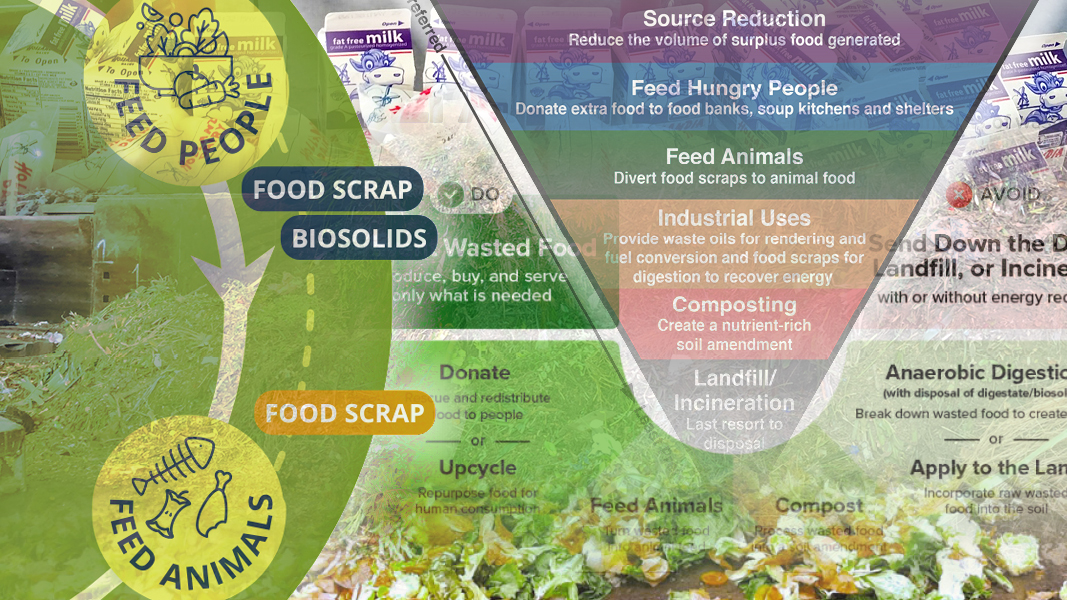Top: Collage of proposed natural circularity image (on left) and existing U.S. EPA food recovery and recycling graphics (on right). Design by Doug Pinkerton.
Jessica Toth
As a kid, I was fascinated by nature’s ecosystems. I am still tickled by the sight of a coyote’s seed-laden scat that will grow a new berry bush for the next coyote generation; termites that break down felled trees; and deep-welled flowers with nectar that can only be reached with a hummingbird’s extended tongue. They are visible demonstrations of interdependence in the natural world — cycles not timelines.
Breaking these natural cycles harms our environment.
In the U.S., we waste a lot of food. Worse, we don’t honor nature’s cycle for managing organic material. Landfilled food generates potent greenhouse gasses significantly more damaging than carbon dioxide and breaks nutrient recycling. It is becoming more commonly known that food waste should be kept out of landfills. Yet, when I survey a national audience of solid waste professionals, the majority are aware, but less than half report jurisdictional programs or plans to address landfill-bound food.
We need a systems framework for conveying why nature’s cycle is important — not just a structured list for what we strive for (Figures 1 and 2). A single food cycle model could be used in third-grade classrooms as well as for government policy discussions. The concept of nutrient recycling needs to be clear to all.
Models For Food Waste Management
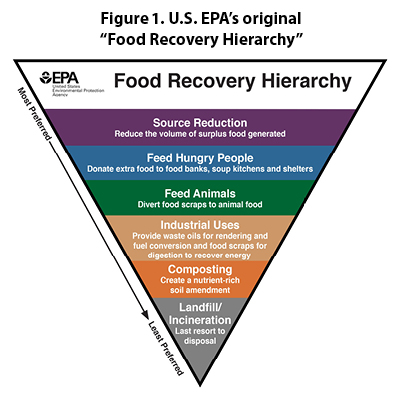 The October 2023 EPA report, “Quantifying Methane Emissions from Landfilled Food Waste,” finds that methane from landfills is the third largest source of emissions in the U.S. and food waste is the most significant contributor, responsible for 58% of methane emissions from landfills. That’s huge! And solvable. Further, a study published in Science in March 2024 (Cusworth et al., 2024) quantified methane emissions using airborne imaging spectrometers and found that landfill emissions are underreported by the ground survey methods used. The data is visualized on the landfill methane-release dashboard created by Industrious Labs and presented on Carbon Mapper’s website.
The October 2023 EPA report, “Quantifying Methane Emissions from Landfilled Food Waste,” finds that methane from landfills is the third largest source of emissions in the U.S. and food waste is the most significant contributor, responsible for 58% of methane emissions from landfills. That’s huge! And solvable. Further, a study published in Science in March 2024 (Cusworth et al., 2024) quantified methane emissions using airborne imaging spectrometers and found that landfill emissions are underreported by the ground survey methods used. The data is visualized on the landfill methane-release dashboard created by Industrious Labs and presented on Carbon Mapper’s website.
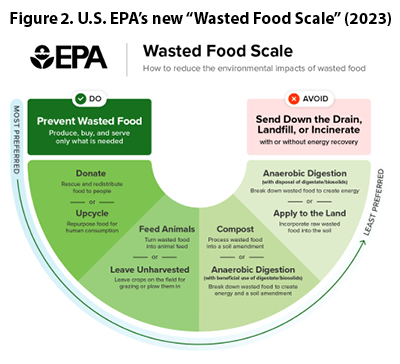 Another recent U.S. EPA report on food waste reduction and disposal, “From Field to Bin: The Environmental Impacts of U.S. Food Waste Management Pathways,” (U.S. EPA, 2023) introduced a new framework for managing surplus food (Figure 2). The report methodically analyzes the successively less beneficial methods of handling food surpluses — from feeding people to feeding animals to composting and anaerobic digestion. This framework builds on the EPA’s previous food hierarchy (Figure 1), incorporating several new avenues for excess produce — upcycling, leaving unharvested, and applying directly to land.
Another recent U.S. EPA report on food waste reduction and disposal, “From Field to Bin: The Environmental Impacts of U.S. Food Waste Management Pathways,” (U.S. EPA, 2023) introduced a new framework for managing surplus food (Figure 2). The report methodically analyzes the successively less beneficial methods of handling food surpluses — from feeding people to feeding animals to composting and anaerobic digestion. This framework builds on the EPA’s previous food hierarchy (Figure 1), incorporating several new avenues for excess produce — upcycling, leaving unharvested, and applying directly to land.
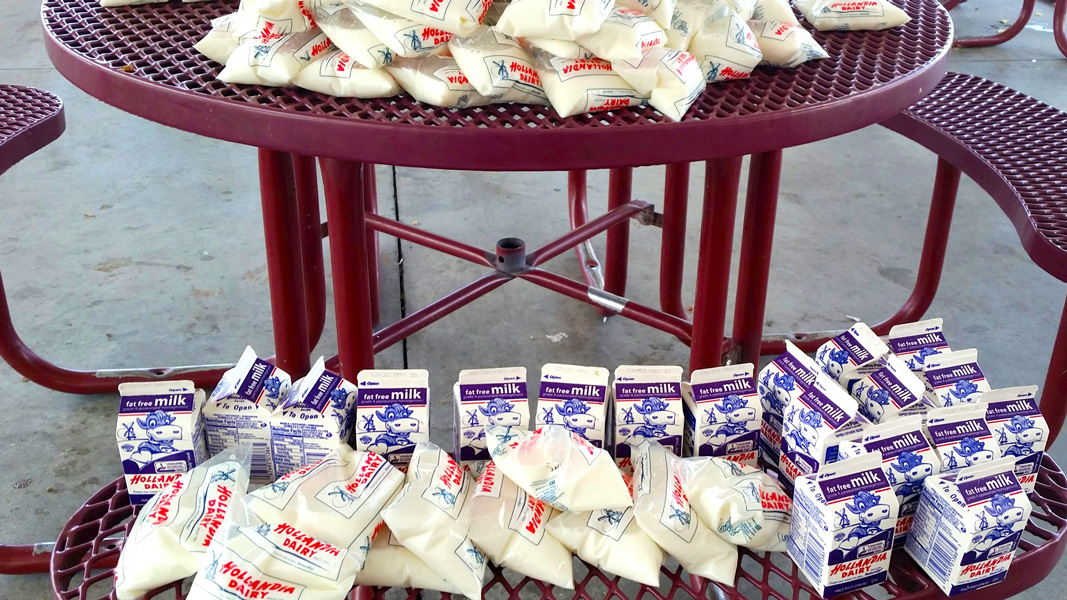
Share tables at schools, inviting students to take what was not consumed at breakfast or lunch, prevents wasted food. Photos courtesy of Solana Center for Environmental Innovation
I believe both depictions miss the mark. They miss the circularity and interdependence that is the beauty of our natural environment and intrinsic to organic materials. They are sequentially linear and do not convey why the pathways are ordered as they are. I’m afraid it will not entice most laypeople, which is who we must reach to achieve wide adoption. I posit a different approach.
Proposed Surplus Food Handling Schematic
Both the old hierarchy and the new EPA scale are uni-directional. The new framework that I propose is informed by the regional work of Solana Center for Environmental Innovation in consulting to food businesses as well as from Solana Center’s community and on-farm composting programs.
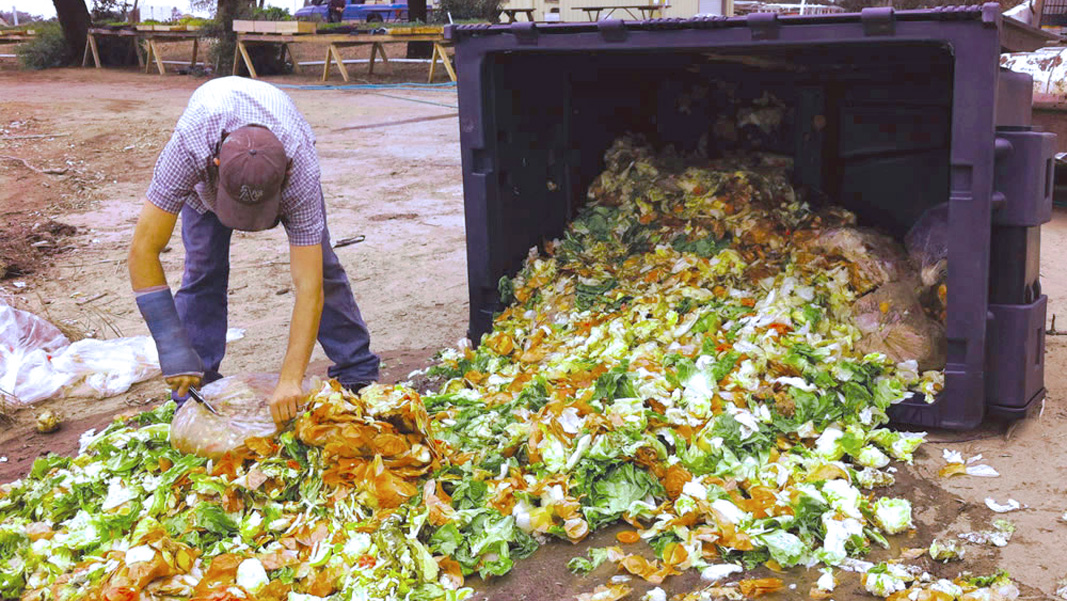
Food scraps delivered to an on-farm composting operation in San Diego County (CA). Finished compost is an agricultural feedstock to grow more food.
When produce is harvested, minerals and nutrients are extracted from the soil. Those nutrients are what make food nourishing for our bodies. We can’t afford to discard the nutrients in uneaten food, nor in gut-processed biosolids. If we continue depleting our soil, the earth will have no remaining farmable land in just 60 years (Arsenault, 2014). Like the coyote, we can return organic material into circulation, ultimately to the soil.
A food model should highlight the inherent circularity of organic material. While I agree with the sequence of methods depicted in the new EPA Wasted Food Scale, consider as the framework for food management a circle with off-ramps and on-ramps (Figure 3). Instead of alternative means of managing surplus food ordered from least to most environmentally damaging, we can think of the synergistic effect of a sequence of interrelated handling stages. The quantity of material is reduced as it is consumed around the cycle, indicated by the narrowing arrow.
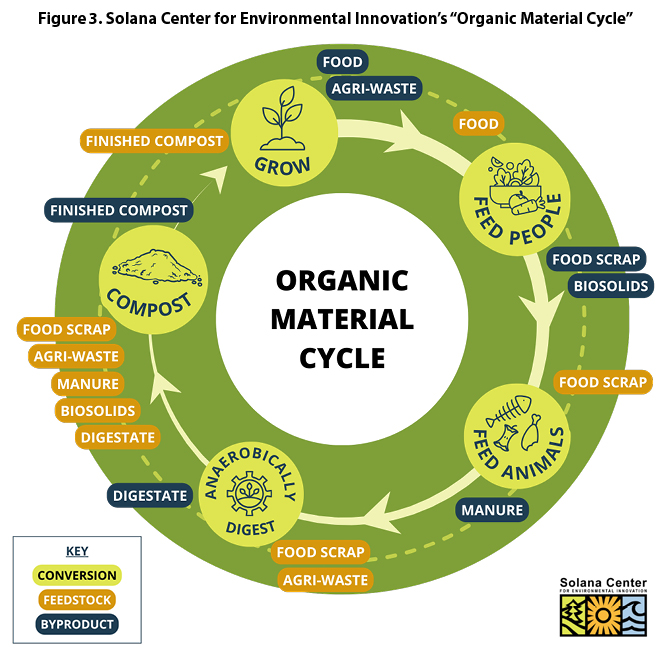 The cycle begins with Growing Food. Progressing through the cycle, food is converted into byproducts that become outputs and later inputs to each successive management method. There is no waste — byproducts continue to contain value for some later process where they become feedstocks. For example, one byproduct of people eating food is “food scrap,” which is feedstock for feeding animals, anaerobic digestion, and composting. We never need to dispose food resources such that they are irretrievably discarded in landfills, sent down the drain to sewer, or incinerated.
The cycle begins with Growing Food. Progressing through the cycle, food is converted into byproducts that become outputs and later inputs to each successive management method. There is no waste — byproducts continue to contain value for some later process where they become feedstocks. For example, one byproduct of people eating food is “food scrap,” which is feedstock for feeding animals, anaerobic digestion, and composting. We never need to dispose food resources such that they are irretrievably discarded in landfills, sent down the drain to sewer, or incinerated.

Inputs (feedstocks) for an anaerobic digester that processes food scraps and green waste in San Diego County.
The organics phases are conversion points, where the feedstock is transformed into byproducts. Feeding People does not need to distinguish between purchased food, donated food, or upcycled food, where, with each, the feedstock is food and the byproducts are food scrap and biosolids. Packaging may go to landfill or incinerator, but there is no path for organic material to these ends.
Two significant differences are conveyed with the proposed schematic as compared with previous models. The proposed depiction shows:
- The inherent circularity of food management that is needed and
- The interdependence of methods for managing food and its byproducts.
The proposed schematic should not be static. When technologies introduce new methods, they will fit into nature’s cycle. That’s a win. We will continue enhancing and improving the natural ecosystem, which should remain at the heart of communication about recovering food’s value.
Actual Sequence Of Food Pathways
As a final note, the U.S. is far from the prioritization of excess food pathways set out in the EPA Wasted Food Scale. The reality is that all methods will continue to be used and more will be deployed. We need to recirculate the byproducts from each method — to find their further “downstream” value, eliminating the need for complete disposal of the resources. Each pathway, except disposal, extracts value in the forms of nourishment and energy. When organic material is sent to landfill, down the drain to sewer, incinerator, or dumped (defined as burning or abandoning material on land or disposing of it in the sea), the food’s resource value goes to zero and the embedded nutrients are lost forever. For this reason, the U.S. must strive to close the loop in addition to prioritizing methods based upon global warming potential.
Figure 4 shows the estimated quantities of surplus food by destination in 2022 according to ReFED (ReFED, 2023). The analysis is ordered by estimated aggregate weight. Notice that currently 50% of excess food is going to Landfill, Sewer, Incineration, or Dumping, over 2.5 times more than to Composting, the next most used method. The actual order of food management methods is almost the reverse of the desired order, with Donation at only 2%.
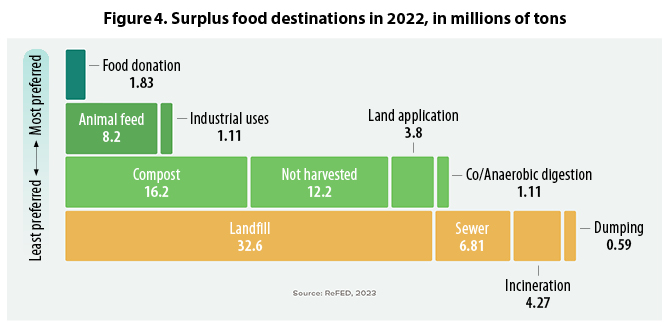 Most important for embracing changes in communicating about food management, people must understand why and then how our food system should function. Only then can we expect communities to internalize and act on what is required and their role in it. That is how we’ll shift the volume of materials to be handled through priority pathways.
Most important for embracing changes in communicating about food management, people must understand why and then how our food system should function. Only then can we expect communities to internalize and act on what is required and their role in it. That is how we’ll shift the volume of materials to be handled through priority pathways.
Jessica Toth is Executive Director of Solana Center for Environmental Innovation, serving southern California. The Center received the US Composting Council’s Organics Diversion Program of the Year award in 2023. Its mission is to empower innovative solutions to climate change through education, community engagement, and research. In April, Jessica was recognized as San Diego County Woman of the Year (2024) by State Senator Blakespear for her inspirational environmental leadership. Please share your feedback about The Food System’s Natural Circularity concept and graphic introduced in this article.


